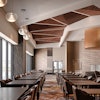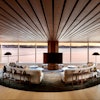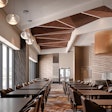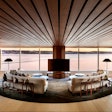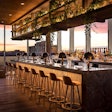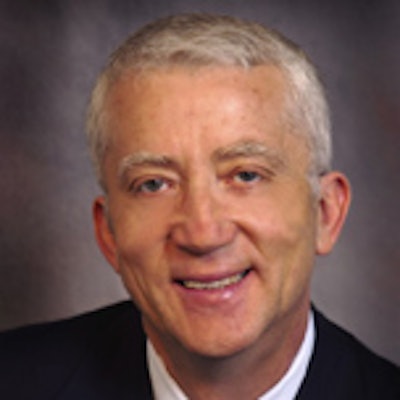
Peter Soumalias
Canada's Walk of Fame
What He Does: As president, CEO, and cofounder of Canada's Walk of Fame, he makes it his mission to celebrate those Canadians who are among the world's greatest talents in sports, entertainment, and the arts.
Staff: Six fulltime staff, plus contracted suppliers responsible for public relations, event production, and security.
Career path: Soumalias began his business career working for his family's firm, Symas Holdings Corp., a manufacturer of personal care products.
Biggest job challenge: Dealing with people issues.
What he's reading: Anything to do with Canadians who helped build the Hollywood entertainment industry.
Favourite Hors D'oeuvres: "I am of Greek heritage, so I love saganaki, or flaming cheese."
For several years after it was founded in 1998, Canada's Walk of Fame relied on government grants for over half its budget, but it shifted to a private-sector financing model three years ago. Why the change?
It's very easy, and also a bit of a copout, for organizations to turn to the government for help in solving their fiscal dilemmas. A responsible organization analyzes its brands and products to determine the course of action that will best ensure its sustainability; we concluded government funding was not something we could rely on for long-term planning. Governments come and go, policies change, and you don't want to be susceptible to the whims of a new administration. After the board decided to pursue private-sector funding, we conducted research to identify corporate sponsors that would best suit our needs—and we now have ties with MasterCard, Volkswagen, Chanel, and Universal, among others. Our next event in June of 2006 will be our third privately- funded production.
Past inductions have taken place at the Royal York Hotel and Roy Thomson Hall, what factors influence your choice of venues?
For the first five hours, the event is largely a television production, so we have to consider a venue's potential to support filming. In the past, we've used Roy Thomson Hall, which is a magnificent facility, but it's a performance hall, not a theatre that you can fly sets in and out of. Last year, we used the Elgin Theatre because it is so well equipped; it has a hundred fly lines and room on stage for multiple sets. As a result, it's possible for us to create a different environment for each induction. Then there are the outdoor requirements: We need to be able to close down streets, set up bleachers, roll out a red carpet, and accommodate the media and public. Finally, we host a gala party as part of the event, so the venue needs to have the space and facilities for that as well.
In addition to the induction ceremonies and party, what other events make up the annual Canada's Walk of Fame program?
Over a four day period, there are six evening parties, a number of dinners, and a rock concert to raise funds for charities.
Tell us about a logistical challenge you face in managing the induction event.
Celebrities showing up late—even by five minutes due to signing autographs on the red carpet. We have to adjust quickly to avoid throwing off the rest of the timetable.
What would be your dream venue for a Canada's Walk of Fame?
It would be risky, but I would do it outdoors at the waterfront. I would fill the lake with yachts, and at a predetermined time have all the yachts turn on their lights. At the same moment, I would have fireworks go off behind them. If I had the budget and the guts, I would love to do it.
How do you plan for the gala dinner?
We don't profess to know everything about the event industry, so we bring in three or four of the best party planners and caterers in the city and get their ideas on what we should do.
What is the most challenging element to managing the celebrity guests?
In some cases, you have to oversee their travel arrangements, accommodations, and even security. The publicists and managers for Canadian celebrities based in Los Angeles often want to be sure that there are private and secure areas for their clients at the event, so they don't have to mix and mingle with everyday people. However, it's been our experience that the stars want to mix with people once they get here.
Does a particular memory from the induction events stand out for you?
Running through the crowd outside Roy Thomson Hall with Jim Carrey while he signed autographs, had his picture taken—and sidestepped the droppings left on the ground by the police horses. It was funny how he did that so skillfully and playfully.
In 2006 WWE super star Trish Stratus is set to take the reins as event host, what made you chose her?
Trish is someone we had considered for a while. We recently discovered that our audience has gotten younger and we need to address that. When looking for a host who matched our new 18-49 year old demographic, at the end Trish Stratus was at the top of the list. The only downside is that I have to work really closely with her for three months (chuckles).
Canada's Walk of Fame
What He Does: As president, CEO, and cofounder of Canada's Walk of Fame, he makes it his mission to celebrate those Canadians who are among the world's greatest talents in sports, entertainment, and the arts.
Staff: Six fulltime staff, plus contracted suppliers responsible for public relations, event production, and security.
Career path: Soumalias began his business career working for his family's firm, Symas Holdings Corp., a manufacturer of personal care products.
Biggest job challenge: Dealing with people issues.
What he's reading: Anything to do with Canadians who helped build the Hollywood entertainment industry.
Favourite Hors D'oeuvres: "I am of Greek heritage, so I love saganaki, or flaming cheese."
For several years after it was founded in 1998, Canada's Walk of Fame relied on government grants for over half its budget, but it shifted to a private-sector financing model three years ago. Why the change?
It's very easy, and also a bit of a copout, for organizations to turn to the government for help in solving their fiscal dilemmas. A responsible organization analyzes its brands and products to determine the course of action that will best ensure its sustainability; we concluded government funding was not something we could rely on for long-term planning. Governments come and go, policies change, and you don't want to be susceptible to the whims of a new administration. After the board decided to pursue private-sector funding, we conducted research to identify corporate sponsors that would best suit our needs—and we now have ties with MasterCard, Volkswagen, Chanel, and Universal, among others. Our next event in June of 2006 will be our third privately- funded production.
Past inductions have taken place at the Royal York Hotel and Roy Thomson Hall, what factors influence your choice of venues?
For the first five hours, the event is largely a television production, so we have to consider a venue's potential to support filming. In the past, we've used Roy Thomson Hall, which is a magnificent facility, but it's a performance hall, not a theatre that you can fly sets in and out of. Last year, we used the Elgin Theatre because it is so well equipped; it has a hundred fly lines and room on stage for multiple sets. As a result, it's possible for us to create a different environment for each induction. Then there are the outdoor requirements: We need to be able to close down streets, set up bleachers, roll out a red carpet, and accommodate the media and public. Finally, we host a gala party as part of the event, so the venue needs to have the space and facilities for that as well.
In addition to the induction ceremonies and party, what other events make up the annual Canada's Walk of Fame program?
Over a four day period, there are six evening parties, a number of dinners, and a rock concert to raise funds for charities.
Tell us about a logistical challenge you face in managing the induction event.
Celebrities showing up late—even by five minutes due to signing autographs on the red carpet. We have to adjust quickly to avoid throwing off the rest of the timetable.
What would be your dream venue for a Canada's Walk of Fame?
It would be risky, but I would do it outdoors at the waterfront. I would fill the lake with yachts, and at a predetermined time have all the yachts turn on their lights. At the same moment, I would have fireworks go off behind them. If I had the budget and the guts, I would love to do it.
How do you plan for the gala dinner?
We don't profess to know everything about the event industry, so we bring in three or four of the best party planners and caterers in the city and get their ideas on what we should do.
What is the most challenging element to managing the celebrity guests?
In some cases, you have to oversee their travel arrangements, accommodations, and even security. The publicists and managers for Canadian celebrities based in Los Angeles often want to be sure that there are private and secure areas for their clients at the event, so they don't have to mix and mingle with everyday people. However, it's been our experience that the stars want to mix with people once they get here.
Does a particular memory from the induction events stand out for you?
Running through the crowd outside Roy Thomson Hall with Jim Carrey while he signed autographs, had his picture taken—and sidestepped the droppings left on the ground by the police horses. It was funny how he did that so skillfully and playfully.
In 2006 WWE super star Trish Stratus is set to take the reins as event host, what made you chose her?
Trish is someone we had considered for a while. We recently discovered that our audience has gotten younger and we need to address that. When looking for a host who matched our new 18-49 year old demographic, at the end Trish Stratus was at the top of the list. The only downside is that I have to work really closely with her for three months (chuckles).

